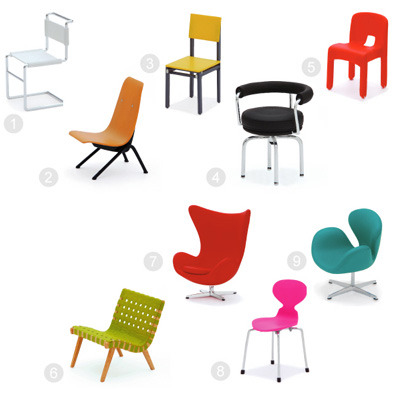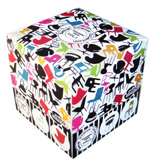
This collection includes miniature reproductions of some of the most famous pieces of furniture of the 20th century, 1:12 scale.
1. Cantilever, 1926
Designer: Mart Stam
This cantilever was designed in 1926 and put into production in 1927. It is similar in form to a chair attributed to Breuer by Thonet in their production of 1927. In a law suit of 1926 to 1932, the German courts attributed the models to Stam. In the earliest Stam production version there was a horizontal bar between the front legs. In the Breuer version, as well as all later version, the horizontal bar was replaced by a support under the seat.
In 1923, Gerhard Stuttgen, a teacher at the Cologne Art School made a cantilever chair using flexible Mannesmann tube. This was exhibited at a student-faculty show of 1924. At the time no one seems to have understood the significance of this invention, In late 1924, Mart Stam, presumably unaware of the chair of Stuttgen, also conceived the idea of the cantilever. Stuttgen's starting point was technical rather than architectural. In all probability, he merely wanted to demonstrate what could be done with Mannesmann tube. Stam, on the other hand, saw the cantilever as a rotation of planes. Not being a metal expert, his first chair was a rigid cast iron tube with plumber joints at the bends.
In 1925–1926 Stam was in contact with Mies van der Rohe who had invited him to participate at the Weissenhof Housing Exhibition. It is presumed that Mies told Stam of the new bending equipment that Breuer was using at the Bauhaus. Also, in all probability, Mies derived his idea of the cantilever from Stam. Several weeks after Stam's straight legged cantilever arrived at the Exhibition, Mies unveiled his curved leg cantilever.
2. Antony, 1954
Designer: Jean Prouvé
Designed at the beginning of the 1950s for the Cité Universitaire at Antony near Paris, this chair was one of Prouvé’s last efforts in the field of furniture design. The salient feature of this unique item of seating furniture is its unconventional construction, which Prouvé successfully combined with a strikingly dynamic shape. Frame made of lacquered sheet and tubular steel, seat shell made of moulded wood, oak veneer with natural wood look.
3. Military Chair, 1923
Designer: Gerrit Thomas Rietveld
This chair is a part of the series designed for the interior of the Catholic Military Academie in Utrecht. Unlike previous experimental furniture designs (such as the Red Blue Chair), the contact called less for a programmatic statement on chairs and more for stability, lightness and lowest possible production cost.
In 1923 Rietveld received a commission from P. van der Pluym, the owner of the shop named Wessels, to make chairs for the Catholic Military old-age Home in Utrecht. The stretchers and legs of this chair are joined by notches which were further strengthened by large bolts and nuts. The short back support is fastened to the tapered rear legs of the chair with the same bolts.
The design for the Catholic Military Academy underscores the open construction, which had become Rietveld’s trademark.
Military chair is part of the Vitra Design Museum collection, Germany.
4. Rotatin Chair LC7, 1929
Designer: Le Corbusier
This design evolved from a series of experiments, including fashioning a chair by wrapping inner tubes from tires around a steel frame.
This swivel armchair was designed in 1929 with Charlotte Perriand. Just like all other releases at the Salon D’Automne in Paris, this armchair was also based on the human scale.
5. Universal,
Designer: Joe Colombo
Originally an artist, Joe Colombo opened a design studio in Milan in 1962 to apply the bold, curvaceous forms—and hatred of sharp corners and straight lines—that had characterised his art to product design. He also strove to apply new technologies to develop new types of furniture. Obsessed by making a chair from a single piece of material, Colombo first tried to develop the Universale stacking chair in aluminium, but then experimented with ABS plastic. Light, portable and easy to clean, the Universale is also adjustable as its legs can be unscrewed and replaced with longer ones. Colombo strove for two years to perfect it for mass-production.
It was the first chair to be fully produced in a single plastic: first in ABS and then in polypropylene. It is stackable both vertically and horizontally. Removable feet could be substituted with smaller ones for height adjustments. A base element was studied in order to create higher seating, such as for use at the bar or in design studios, as highchairs, or for industry. Only a prototype of the armchair version exists.
6. Risom 654W Lounge, 1941
Designer: Jens Risom
This chair was designed by Danish Jens Risom in 1941. It reminds of the Alvar Aalto’s Lounge Chair from Artek, but Risom chair is great for smaller spaces like bedroom or hallway. Knoll still manufactures the chair, and it’s available in different colors.
7. Egg, 1958
Designer: Arne Jacobsen
This chair was designed in 1958 for Radisson SAS hotel in Copenhagen. The design has become iconic and is internationally recognizable.
Arne Jacobsen was one of Denmark’s most successful architects and designers, who contributed greatly to developing the Danish Modern style and to architectural functionalism. He was born in Copenhagen, trained as a mason, then studied at the Royal Danish Academy of Arts. Jacobsen embraced a functionalist approach from the outset. He was among the first to introduce modernist ideas to Denmark and create industrial furniture that built upon on its craft-based design heritage.
Best known and most fully integrated works, are the Royal Hotel Copenhagen, the Danish National Bank and St. Catherine’s College, Oxford. His Ant Chair has come to symbolize Scandinavian design. His most successful design was Model 3107 (or Series 7) that sold in over 5 million. Both chairs are produced by Fritz Hansen.
8. Ant, 1952
Designer: Arne Jacobsen
This chair designed by Arne Jacobsen is beautiful and elegant, however, it wasn’t immediately popular in 1952 when Fritz Hansen launched it. The chair had only 3 legs and no arms!
In 1951, Jacobsen completed work on the Ant Chair, Model 3100, an intricately moulded plywood seat on three splindly steel legs.
This was followed by the simpler hourglass form of the 1955 Model 3107, Series 7 Chair. Like the Ant, the Series 7 was perfect for modern living being light, compact and easily stackable.
It was popularized featuring on the set of the BBC soap opera East Enders.
From left to right: Grand Prix, Ant, Model 3107
9. Swan, 1958
Designer: Arne Jacobsen
In 1958 the Swan was a technologically innovative chair. No straight lines—only curves. A moulded shell of synthetic material on an aluminium star swivel base. The Swan chair was designed for the Royal Hotel Copenhagen along with other furnishings. The shell is polyurethane foam with glass fibre reinforcement. It comes with leather or fabric upholstery.
Japan
Weight: 850 g
Produced by Reac Japan
Materials: plastic, vinyl, rubber
Package dimensions: 300×300×100 mm (11.8″×11.8″×3.9″)
Not recommended for children under 7.

Shipment and payment
We accept Visa and Mastercard as methods of payment. Purchases delivered by courier in Moscow, Russia can be paid for with cash.
We can ship almost anywhere in the world. Shipping costs and available delivery methods (courier, mail, or pick up) will be shown during checkout. Delivery time and cost will vary based on the chosen service, order weight and distance to the destination.
If you are not satisfied with your purchase for any reason, we'll take it back, no questions asked.
See all reviews
See all reviews